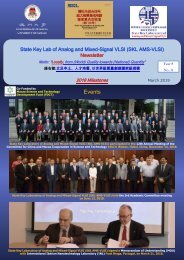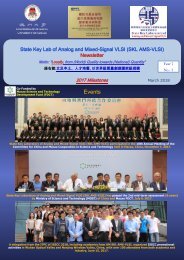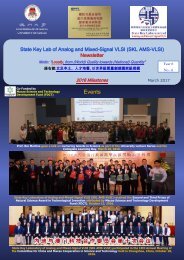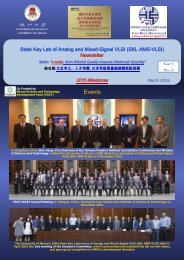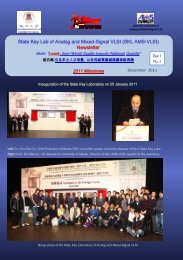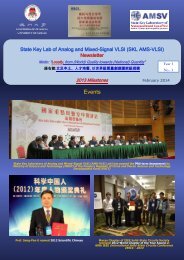AMSV Newsletter 2014
AMSV Newsletter 2014
AMSV Newsletter 2014
Create successful ePaper yourself
Turn your PDF publications into a flip-book with our unique Google optimized e-Paper software.
Voltage<br />
Voltage<br />
In American Institute of Physics – Advances <strong>2014</strong><br />
Natural Discharge after Pulse and Cooperative Electrodes to<br />
Enhance Droplet Velocity in Digital Microfluidics<br />
Tianlan Chen, Cheng Dong, Jie Gao, Yanwei Jia, Pui-In Mak, Mang-I Vai, and Rui P. Martins<br />
From Multidisciplinary Research Area<br />
Motivation<br />
Architecture<br />
Digital Microfluidics (DMF) is a promising technology<br />
for biological/chemical micro-reactions<br />
due to its distinct droplet manageability via electronic<br />
automation, but the limited velocity of<br />
droplet transportation has hindered DMF from<br />
utilization in high throughput applications.<br />
In this paper, by adaptively fitting the actuation<br />
voltages to the dynamic motions of droplet<br />
movement under real-time feedback monitoring,<br />
two control-engaged electrode-driving techniques:<br />
Natural Discharge after Pulse (NDAP)<br />
and Cooperative Electrodes (CE) are proposed.<br />
They together lead to, for the first time, enhanced<br />
droplet velocity with lower root mean<br />
square voltage value.<br />
uα<br />
uβ<br />
uβ’<br />
0<br />
uα<br />
uβ<br />
uβ’<br />
0<br />
HV period<br />
tα’<br />
LV period<br />
tβ<br />
tα<br />
1 st electrode<br />
tthc<br />
tths<br />
tths<br />
Time<br />
NDAP<br />
2 nd electrode<br />
NDAP + CE<br />
(a)<br />
(b)<br />
uα<br />
0<br />
uα<br />
0<br />
Sketches of four possible electrode-driving schemes for droplet movements<br />
over two electrodes: (a) Natural Discharge after Pulse (NDAP): The highvoltage<br />
(HV) period lasts shorter, while the low-voltage (LV) under natural<br />
discharge lasts longer with short pulse recharging periodically. (b) DC signal.<br />
(c) NDAP with cooperative electrodes (CE) overlaps the charging time of<br />
neighboring electrodes. (d) DC plus CE driving. (e) Droplet moving toward<br />
two target electrodes and location of the two thresholds on the first target<br />
electrode. The electrode was grounded when the charging was done in all<br />
schemes.<br />
tthc<br />
tths<br />
tths<br />
Time<br />
DC<br />
DC + CE<br />
(c)<br />
(d)<br />
thc<br />
ths<br />
1st<br />
2nd<br />
(e)<br />
Result I<br />
Result II<br />
(a) Velocity comparison of NDAP signals with different and DC. NDAP with<br />
13-ms to 100-ms has average velocities higher than DC signal. (b) Video<br />
frames of a droplet actuated by NDAP and DC crossing 2 electrodes<br />
(Multimedia view). Video was captured by a high speed camera (Nikon V2),<br />
which has a maximum frame rate up to 1200 frames/second (resolution 320<br />
x 120 pixels). A LED light was set in the same frame to light on when the<br />
electrode was being charged. Individual frames extracted from the videos<br />
were analyzed by the image processing software Image J to obtain the<br />
v droplet.<br />
Comparison between the proposed (NDAP + CE and high-speed feedback)<br />
and classical (DC) schemes for droplet movements in a long run of 3 s: (a)<br />
Droplet successfully moved across 12 electrodes when it was controlled by<br />
the proposed scheme. The path of the droplet’s center had been shortened<br />
at electrode No. 6 by CE, which charged electrode No. 7 before the droplet<br />
reached electrode No. 6, resulting in an upward move of droplet in advance.<br />
The whole droplet transportation was recorded in video (Multimedia view).<br />
(b) Droplet failed to complete movement in 3 s due to its lower speed. The<br />
moving path was close to the right angle at the two corners. The whole<br />
droplet transportation was recorded in video (Multimedia view). (c) Instantaneous<br />
velocity of the droplet moving across the electrodes. As expected,<br />
droplet controlled by the proposed scheme moved across electrode No. 6-7-<br />
8 using a much shorter time than that of the classical procedure.




